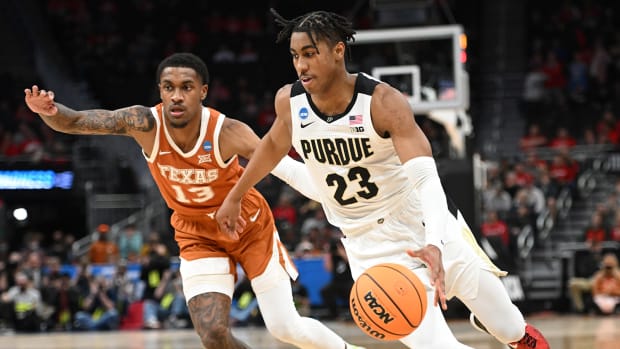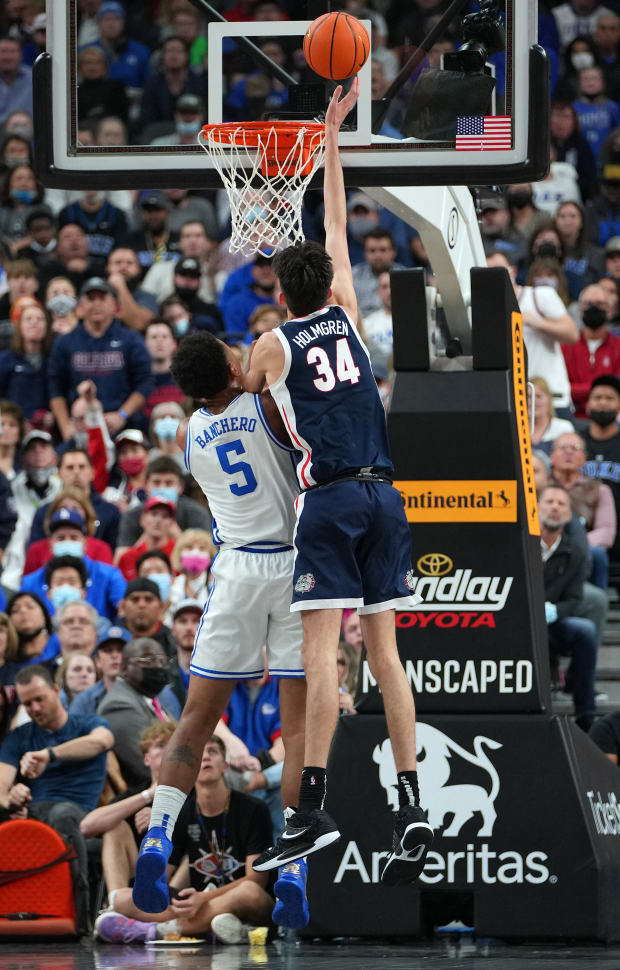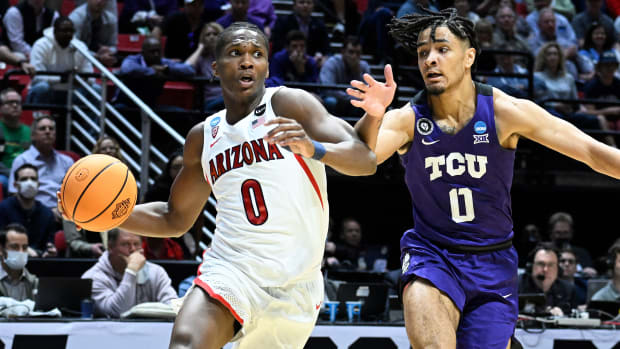The second week of NCAA tournament games tips off Thursday night, and despite some unexpected early exits from highly ranked teams, top draft prospects remain well represented in the Sweet 16. NBA-minded observers were hoping to see big names—including Jabari Smith, Keegan Murray and Johnny Davis—play deep into the tournament, but hey, we don’t always get what we want. And there’s still plenty of appointment viewing on tap over the next four days at minimum, with three widely projected top-five picks (Chet Holmgren, Paolo Banchero and Jaden Ivey) and a handful of other projected first-rounders still hanging around.
Here are the biggest remaining prospect story lines for NBA fans to follow in the coming days, some of which may have real bearing on how the top of the 2022 draft shakes out.
How far can Jaden Ivey take Purdue?
Ivey turned in one of the most impressive performances I’ve seen in person all season, and perhaps the most complete game of his college career, in Purdue’s second-round win over Texas. He was patient, picked his spots, drew defenders and made plays for teammates. He hit a pair of huge shots to help close the game, too. The highlight reel just from that game sufficiently illustrates his upside, including a vicious dunk in traffic, a full-sprint chase-down block and a few eye-popping passes that led to open shots. Ivey has been visibly more bought-in on defense, as well, communicating with teammates and playing more focused away from the ball, where his athleticism and length should theoretically be a major plus.

Benny Sieu/USA TODAY Sports
If Ivey continues to play with that level of focus and Purdue keeps rolling—which is certainly possible given their relatively easy route to the Final Four (the Boilermakers draw Saint Peter’s and, if they advance, would face the winner of UCLA–North Carolina)—the likelihood he cracks the draft’s top three will keep increasing. While his general status as a likely top-five pick has been more or less solid for a couple of months, there were salient questions from NBA teams coming into this tournament, which centered less on his talent and more on his inconsistent effort and engagement level over the course of the season. For those skeptical on that front, it’s certainly been helpful to see Ivey is capable of tapping into a heightened competitive gear.
Ivey likely projects better as a dynamic combo guard and not a true point in the NBA, but to some extent those are semantics in a league where so many teams deploy multiple ballhandlers. It was already hard to see him lasting long on draft night, and if he continues this level of play, he becomes a more viable name in the discussion at No. 1. As things stand, Jabari Smith remains the best bet to go first, but the fact he struggled as Auburn bowed out early gives the other contenders a chance to leave lasting impressions in the tourney.
Will we get a Holmgren-Banchero rematch?
If Gonzaga and Duke can defend their seeding and advance past Arkansas and Texas Tech, respectively, a second matchup between projected top-four picks Chet Holmgren and Paolo Banchero will gift lottery teams an extra evaluation point as they prepare for potential decisions at the very top of the draft. This is all a big what-if, of course, as Gonzaga hasn’t looked particularly good in this tournament, and a very young Duke team will contend with the best defense it’s seen all season. But getting to see a second high-quality game with Holmgren and Banchero on the court at a later stage of the season would (obviously) be invaluable for teams that may eventually have to decide between them.
Holmgren didn’t play his best game in a win over Memphis—he managed nine points and stopped being aggressive as a scorer early on—but he was still sufficiently impactful, blocking four shots, altering countless more and keeping freshman counterpart Jalen Duren in check. It’s important to remember Duren is not a particularly accomplished post-up player, but it does bode well that the 7'0", 190-pound Holmgren held his own against Duren’s strength. The recipe for attacking Holmgren one-on-one is still relatively simple: Drivers have to bump his chest before separating for a shot, and once he’s thrown off balance, it’s often hard for him to recover. But that can be easier said than done. And when he’s roving around as a help defender and able to use his length while physically unfettered in the run of play, Holmgren’s defensive talent shines through.

Stephen R. Sylvanie/USA TODAY Sports
It’s worth noting that Holmgren’s now shooting 1-of-14 from three-point range in his last five games. Teams will want to see him be more aggressive offensively against an Arkansas team that can’t really match his size, other than center Jaylin Williams, who’s also a prospect.
Banchero, on the other hand, has rediscovered a three-point stroke that was missing at the ACC tournament, making a pair of threes in each of his tourney games. He also looks more confident in his midrange shot and worked as an effective offensive fulcrum for Duke against Michigan State. This is much closer to what scouts expected to see from him based on his early-season play: He’s a well-rounded, smart player and an excellent passer with a diverse skill set. When his jumper goes missing, Banchero is much, much easier for opponents to contend with, as it’s easier to sit back and neutralize some of his strength and coordination attacking the rim. One critique I’ve heard from scouts is that Banchero often relies too much on finesse and not enough on his physical gifts. His performance against a supremely tough and aggressive Texas Tech defense, which will likely crowd him all game, will be a useful data point.
Should we get Gonzaga-Duke Round 2 (and this time, with Coach K’s retirement date on the line), it will again be must-watch stuff. During the November game, Banchero outplayed Holmgren on whole before experiencing cramps that forced him to miss most of the second half. Holmgren struggled in the first half of that game and played better in the second, but Gonzaga lost. Another Duke projected first-rounder, Mark Williams, dominated the interior play. Of course, both teams have evolved four months later, making this a fascinating scenario. Cross your fingers.
Where is Bennedict Mathurin’s ceiling?
However good scouts thought Bennedict Mathurin was after his impressive but incomplete freshman year, he’s continued to challenge those notions with his progress over the course of his sophomore season. He rescued top-seed Arizona with 30 points in a tight game it easily could have lost. Mathurin was just 3-of-11 from three, but hit a big shot off the bounce to send the game to overtime. Then he won a huge offensive rebound and finished in traffic in overtime. He was also aggressive to the point of taking 13 free throws (after taking 15 in the Pac-12 title game). The book on Mathurin has always been that he’s an elite run/jump athlete with upside, but it’s starting to become clearer what that upside might actually look like. His emergence as a confident late-game scorer is noteworthy.

Denis Poroy/AP
In his first year on the job, Arizona coach Tommy Lloyd made a point of expanding Mathurin’s opportunities playing in ball screens, designed to help him get downhill but also expand his comfort level making reads. Mathurin’s passing was always a point of critique coming up with the NBA Academy, and nobody will mistake him for a point guard. But certainly, his ability to play the two-man game (often aided by a giant target in Christian Koloko) has expanded. Against TCU he also showcased improved ability to skip the ball across the court going to his right hand. He’s been doing these things in small doses all season, and the perception of Mathurin as primarily a great transition player and not as much of a creator has rightfully shifted, at least to some degree.
Mathurin is still not a great improviser, as much of his playmaking for teammates comes in those designed ball-screen situations—in the NBA, he may not be a guy who breaks off possessions to go get buckets. But in the context of the other guards and wings in the mid-to-late lottery, he’s certainly building a strong case. Mathurin has the size and athletic edge on Johnny Davis, he’s a more accomplished scorer than Dyson Daniels, and he’s further along in his development than Shaedon Sharpe, who didn’t play at all this season and remains somewhat enigmatic as far as the NBA’s present comfort level is concerned. While likely not a No. 1 scoring option in the long run, if Mathurin keeps taking over games like this, it certainly doesn’t hurt his projection as a potential starting-caliber wing.
Who is the second-best prospect on Duke?
While Banchero is far and away Duke’s most well-regarded prospect, there’s disagreement around the league as to which of the Blue Devils’ other prospects should come off the board second. There seems to be a degree of public assumption that it will be freshman wing AJ Griffin, who has shot the ball well this season but hasn’t been the picture of consistency. While canvassing the opinions of scouts this week, there was plenty of support for sophomore center Mark Williams, who has been a quiet pillar of Duke’s success. The Blue Devils’ other principal engine, junior Wendell Moore, also has plenty of fans, to the point where he’s entered this conversation in the minds of some scouts (although not the popular choice in this query). Freshman Trevor Keels hasn’t played overly well down the stretch and is viewed as more of a late first-rounder right now.
While Griffin has been a key piece for Duke since entering the rotation full time in December, he hasn’t been particularly consistent, and other than his 45% three-point shooting clip (which many scouts feel may be due for regression, due to his average free throw shooting), his calling card to this point has primarily been his reputation. Griffin struggles to get to the rim, doesn’t draw many fouls and hasn’t shown a pronounced, functional athletic advantage other than some nifty dribble moves—and in order for him to score, he frequently stops the ball. He’s been efficient with the opportunities he’s gotten, and the hope is that considering his age (he turns 19 in August) and history of injuries, Griffin can stay healthy and access a higher gear athletically in time. On the flipside, there’s a case to be made that Griffin has simply been coasting off the five-star reputation he acquired early in a high school career in which, frankly, he didn’t play games all that often due to injuries and the onset of COVID-19. The upside argument is certainly there to be made, but most scouts I’ve spoken with don’t view him as a lock to come off the board in the top 10.
Williams has become a popular name due to just how steady he’s been all season: He protects the rim by blocking and altering shots, regularly changes the game with his size and is a powerful finisher with solid touch around the basket. He also runs the floor and shoots free throws well for a 7-footer, which helps cover for the fact he’s not a good jump shooter. Arguably the most crucial skill for role-playing bigs in today’s NBA (particularly those who don’t space the floor) is consistency, in terms of competing all the time and making the simple plays. Williams was a late-blooming prospect and has started to really understand his role, and there’s debate as to whether he or Jalen Duren should be the first center off the board on draft night. He could certainly sneak into the late lottery depending on how the order breaks.
Lastly, a word on Moore, who has become one of my personal favorite prospects and the rare Duke star who’s gone underrated all season: The way the Blue Devils play, in some respects, does him few favors. Moore is Duke’s best transition player and a terrific open-court passer and athlete, but oftentimes their offense grinds to a halt, leading them to play through Banchero inside. When allowed to operate unfettered in space, Moore naturally plays beautiful team basketball, with his playmaking vision and improved three-point shooting a total revelation this season and a testament to his rediscovered confidence after his first two difficult seasons. Many McDonald’s All-Americans don’t quite recover from early struggles in college: Moore has legitimately reimagined himself as a player, and he’s a much more functional athlete, as well. Sign me up for Moore, who can guard multiple positions, play out of any spot on the perimeter and understands his role in making teammates better. That’ll play as a fourth or fifth option in the NBA.
Which sleepers will break out?
Lastly, a few less-heralded names to watch as the games continue. There are two players left in the field who’ve been identified as potential first-rounders in 2023: Arizona’s Dalen Terry and Iowa State’s Tyrese Hunter. It feels unlikely either gathers enough momentum over the next two weeks to make the NBA leap this spring, but they’re both legit prospects who are playing key roles on their teams.
Terry is a tall, unselfish, connective player who has improved as a jump shooter and from a maturity standpoint, and has moonlighted at point guard for Arizona from time to time. Teams still have questions about his shot, and he’ll need to improve his frame a bit, but he facilitates ball movement and has a good base set of skills to work with. He briefly lived in infamy at the end of Sunday’s game for dunking the ball in transition instead of laying it up before time expired; hopefully that was a learning experience.
As for Hunter, he’s been on and off our draft board this season as a potential late first-rounder, but he is still 18 years old and has a good case to return and keep developing in college. He’ll need to put on physical strength to help himself finish through contact, refine his jump shot (which is capable but streaky) and expand his passing repertoire. If Iowa State can find a better big to help him play in ball screens next year, it’ll help. Hunter is jet-quick, allowing him to wreak havoc defensively, and extremely poised for a teenager. He won Big 12 Freshman of the Year and is not a secret.
Two older prospects to keep an eye on, as well: Start with Miami’s Kameron McGusty, an athletic wing scorer with a streaky shot who has been around so long he played at Oklahoma with Trae Young. He’s played a big part in his team’s unexpected run and put himself in the conversation for a potential two-way contract. Another guy who personally intrigued me up close is Arkansas wing Stanley Umude, who has an NBA frame and put together some terrific showings as a supporting scorer and rebounder. He may have to spend some time defending Chet Holmgren on Thursday night, depending how undersized Arkansas decides to cover Gonzaga’s bigs. It’ll be his best opportunity of the year to leave a good impression.







